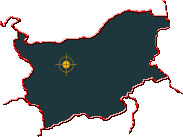|
|
|
 Name:
Троян (Troyan). Sometimes, the spelling Trojan is used as well.
I'm not sure if the name has anything to do with the ancient Troya in
→Turkey. As a matter of fact, 'Troyan' derives from
Via Trayana - a former Roman trade route crossing the mountain range near present-day Troyan.
Name:
Троян (Troyan). Sometimes, the spelling Trojan is used as well.
I'm not sure if the name has anything to do with the ancient Troya in
→Turkey. As a matter of fact, 'Troyan' derives from
Via Trayana - a former Roman trade route crossing the mountain range near present-day Troyan.
Location:
Troyan stretches along the northern foot of
Средна Стара Планина
(Middle Stara Planina aka High Balkan mountains) right in the heart of Bulgaria. The closest bigger city is 30 kilometres away
to the north - it's the local centre Ловеч (Lovech).
South of Troyan, a road leads to the ridge of the mountains and the important Troyan pass (see below). Behind the mountains, the
→Valley of Roses starts. It's around 130 km to the west to the capital →Sofia.
Population: around 28'500
Orientation:
The town is rather small and the centre of an area, where agriculture and pottery play an important role. More interesting than the
town itself is the monastery nearby (see below) and the road to the south, passing the (see →Troyan pass).
History:
The town itself is only 130 years old and therefore rather young. However, there are remainings of much older settlements in the
area. Only a few kilometres away from the town, there's the
Троянски Манастир
(Troyanski Manastir, Troyan monastery). This monastery is the third biggest monastery of Bulgaria, right after
→Rila and →Bachkovo. Troyan Monastery was founded at the end of the
16th century. Even during the long Ottoman occupation, the monastery remained active and played an important role
for the resistance movement against the Ottomans. The Bulgarian national hero and democrat
V. I. Levski (1837-1873) founded the Revolutionary Committee in Troyan. Because of that, he
was sentenced to death by the Ottomans.
Getting there:
Toryan is the terminal station of the railway coming from Lovech in the north. This means, that there
are direct trains from →Veliko Tarnovo and →Ruse to Troyan.
As for other destinations, busses and microbusses are the best bet. Some busses cross the mountains, heading as far as
→Karlovo, →Plovdiv and even to the capital
→Sofia. Note that the pass road can become totally impassable to cars and busses during the winter months.
|